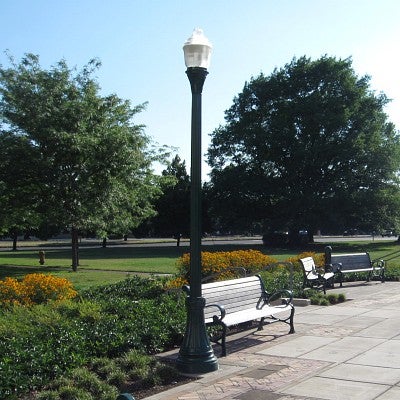
The Campus Outdoor Lighting Plan (PDF) was developed by the Campus Planning Committee and Ad Hoc Committee on Campus Lighting to address safety concerns and adhere to safety regulations for students, faculty, staff, and visitors. The plan includes:
- General Lighting Guidelines;
- Light Fixture Design Criteria;
- Lighting Levels and Ratios; and
- Outdoor Walkway Lighting.
The university recognizes the necessity of campus lighting and exterior building lighting to address adequately the personal safety requirements of students, faculty, staff, and campus visitors without significantly damaging its nighttime aesthetic qualitities, as well as to be consistent with its committment to energy conservation.
General Lighting Guidelines
The following general guidelines apply to the selection, design, and placement of all campus outdoor
lighting:
- Adequately address the personal safety requirements of students, faculty, staff and campus visitors (Campus Plan) as recommended by the UO Police Department.
- Maximize energy conservation (Campus Plan).
- Preserve the campus nighttime aesthetic qualities (Campus Plan).
- Restrict light trespass. In particular, unusual applications, such as illuminating outdoor recreation fields or facilities, need to be designed with the specific activity in mind while protecting adjacent spaces and uses from spillover light to the maximum extent possible (Campus Plan).
- Ensure that main entrances, major walkways and adjacent spaces are well lighted.
- Minimize the difference between lighting levels in adjacent areas to prevent strong contrasts and shadows.
- Eliminate glare to the greatest extent possible.
- Recognize the relationship between lighting and other landscape features such as vegetation. The placement and design of outdoor lighting need to be carefully coordinated with sensitive management of campus vegetation. When possible, lighting engineers and landscape architects should work collaboratively in designing nighttime illuminationimprovements. Minimize the need to substantially trim landscaping while recognizing the need to minimize shadows and provide surveyable surroundings.
- Recognize that uniform lighting is often more important than the amount of lighting when establishing the sense of a safe, well-lit area.
- Recognize that lighting serves as an architectural design element in the landscape setting in addition to its functional qualities.
Lighting Levels and Ratios
Adequate consideration is to be given to the perceptions of the relationship between light and safety as well as the actual measured light conditions. In consideration of this, the University does not subscribe to a specific quantitative illuminance standard. Similarly, the University recognizes the need for uniform light distribution, but does not subscribe to a specific ratio standard.
The general guidelines should be followed when determining appropriate light levels and ratios. In particular, uniformity and quality of light are encouraged over quantity. In all cases, IESNA standards and city regulations shall be met.
Prioritized Plan for Outdoor Lighting Walkways
The creation of a prioritized plan for outdoor lighting walkways will help achieve the general lighting goals described above by helping to provide a sense of a safe night environment on campus while conserving energy to the greatest degree possible and preserving the landscaped, park-like character of campus. The premise behind this network of walkways is that it is of primary importance to encourage people to use well-traveled paths as supported by the UO Police Department. Lighting these walkways identifies them and encourages pedestrians to use them.
Identifying these outdoor lighting walkways does not preclude the possible need to light other areas of campus; rather, it helps determine where to focus lighting efforts as resources become available.
To be designated as outdoor lighting walkways, the routes will:
- Follow all general lighting guidelines (see above).
- Link major building entrances to each other and to primary auto/bike parking areas and transit stops (pay particular attention to buildings that have high levels of nighttime use).
- Add to a sense of a safe night environment.
- Encourage the use of well-traveled areas.
- Correspond with ADA access routes.
- Preserve the landscaped, park-like character of campus.
- Protect significant landscape features.
- Conserve energy to the greatest degree possible.
- Correspond with call box locations.
- Correspond with designated bike paths.
This plan recognizes that City-owned streets are a component of the outdoor lighting walkway network for the campus area. Although the university does not have jurisdiction over these public-right-of-ways, the City should be encouraged to make lighting improvements where necessary.
UO Campus Safety at Night Map
If you have comments or suggestions about lighting, you can use the Safety at Night map to drop a pin on a location and leave a comment. You can also contact Aaron Olsen with Campus Planning.
